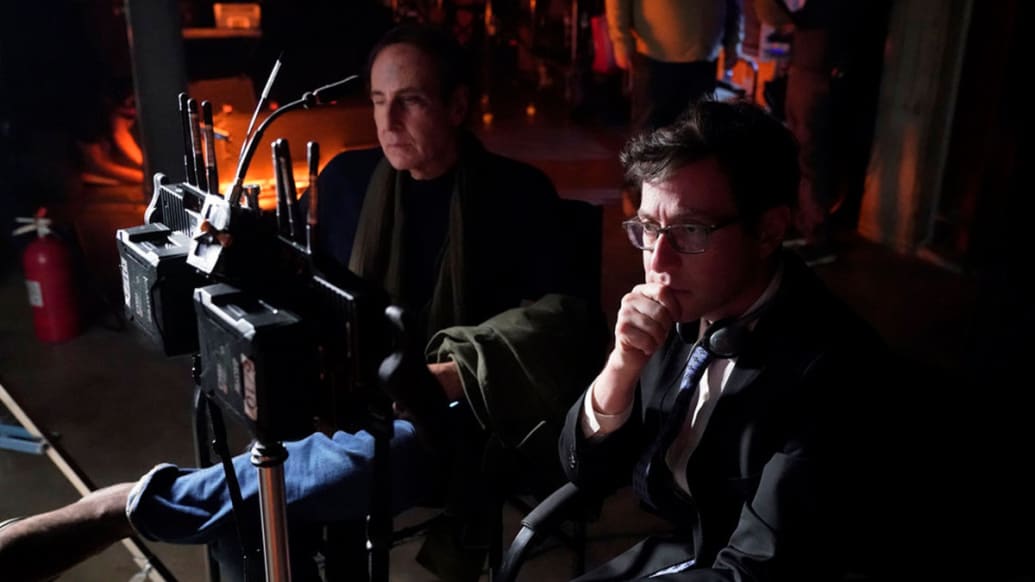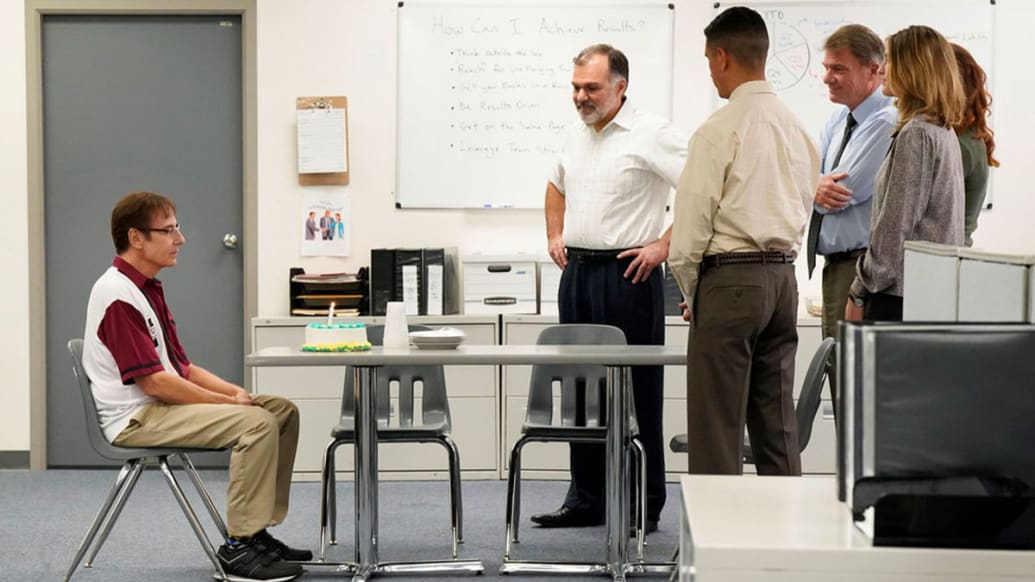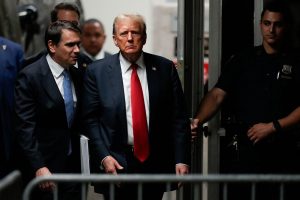There’s weird, there’s bizarre, and then there’s Paul T. Goldman, subject and star of Paul T. Goldman, a Peacock docuseries that attempts to unravel the mystery of its protagonist and his claim that his ex-wife Audrey Munson is a prostitute-turned-madame who’s a member of an international sex-trafficking ring.
Exuding good-natured enthusiasm and dogged determination, Goldman is a riddle wrapped in a mystery inside a wackadoo enigma, convinced he’s on a heroic odyssey to uncover his own personal global conspiracy—one that also involves private investigators, the FBI, and shady characters with names like Royce Rocco.
Jason Woliner’s six-part docuseries attempts to delineate truth from fantasy through head-spinning means, profiling Goldman in straightforward non-fiction fashion, filming dramatic recreations of Goldman’s screenplays (based on his supposedly true book Duplicity, as well as his wholly made-up sequel series The Paul T. Goldman Chronicles), and providing behind-the-scenes glimpses of the making of those staged sequences.
A true-crime investigation by way of a character study via The Rehearsal, Paul T. Goldman is as formally adventurous as it is eye-openingly uproarious, and the sort of bonkers whatsit that defies categorization, blurring the boundaries between the authentic and the artificial with down-the-rabbit-hole gusto.
For Woliner, Paul T. Goldman is a labor of love more than 10 years in the making, and an extension of his prior work on Nathan for You and Borat Subsequent Moviefilm (the latter of which he directed). A deliberately self-conscious endeavor that surprises at every right turn—some of which involve Goldman’s first wife and son, others concerning his on-screen collaborations with accomplished co-stars—it’s like a car crash of various small-screen genres.
Woliner orchestrates his insanity with giddy deftness, segueing between perspectives with an eye toward hilarious revelations and unpredictable exclamations, along the way painting a uniquely off-kilter picture of a man lost in a fugue of heartache, anger and delusion. Suffice it to say, the show is a lot, and thus we relished the chance to chat with Woliner about the series’ long road to completion, whether he believes Goldman’s tall tales, navigating the line between empathy and mockery, and what answers we might expect from the upcoming finale.
There are a million things going on in Paul T. Goldman, and thus I have a million questions. But maybe the most pressing is: Do you believe the story Paul is telling? And just as importantly, does he?
The answer to that is, absolutely. He absolutely believes the story he’s telling.
For me, a lot of the show became, by the end, finding out—as best I could—what was true and what wasn’t. And then exploring how much that mattered, and if he was believing certain things that I could, to the best of my ability, show him I did not think were true, or verify. There’s no black and white answer. This would be a much easier show to make if Paul was wrong about everything, you know? [laughs] Like all of us, he’s right about some things and not right about some things.
Does the finale clear things up?
It’s an attempt to, as best as I could.
Paul is a strange (and possibly delusional) guy, and he’s obviously not a great actor. Thus, by putting him front and center—including in dramatized scenes that he wrote and stars in—did you ever fear that the docuseries might be having fun at his expense? How did you avoid that?
It was a real trick to figure out, because I wanted to explore Paul’s story in this way, and make sure he was on board with it. But I didn’t want this to be a mean-spirited show, and I didn’t want it to be a prank, and just be getting laughs at the expense of Paul or at the fact that he’s not a professional actor.
To me, I always wanted him to be in it, but I didn’t suggest that to him until a few years into the process. Once I met him, I thought the most interesting version would be Paul starring in this, both because it would be awkward and funny and also because of what it would reveal, and how I thought it would be fascinating to see someone walk through their own memories of their life in a way that they can direct. I thought it could be a very interesting way to get into his brain.
I do think he gets better as an actor as the show goes on. Obviously, in that first scene where they’re on the date—the first episode, a lot of it is a pilot that we shot in 2017, and he’s very wooden. He’d never been in front of a camera before. I think that puts people in a certain mindset when they’re watching it, but if you actually look at the next few episodes, he’s interesting. He’s a unique person. He’s fairly odd but we’re not getting laughs at the expense of him or the fact that he’s a bad actor. Hopefully, to me, you kind of just get used to seeing him in all his uniqueness in all these scenes, and what’s funny or interesting or sad or whatever is something else.
If this were a project that just was about laughing at a person, it really wouldn’t have been worth a decade of my time [laughs]. I understood that this would be funny, at first, just putting him in these scenes and seeing what happened. But I was hoping that would fall to the background and it would become interesting in a different way.
Evans Vestal Ward/Peacock
Has Paul seen the initial episodes, and if so, what was his reaction to them?
Paul has seen the first three and bits and pieces of the rest, and I didn’t show them to him while we were shooting because I didn’t want him to be self-conscious about it. I had shown him a few scenes when we shot the pilot, and I thought it might have been a mistake, because he said, “Oh, I’m funny!” and then he would start trying to be funny, and that’s always kind of the death of this thing, where someone is trying hard to be funny and that never leads to anything being funny [laughs]. So I didn’t want him to be self-conscious.
Now that he’s seen the response, and the response on Twitter—people are so effusive to him, and rooting for him, and he’s seeing that yes, there are parts that people are laughing at, but there’s also a vulnerability on display that’s making him come across as very likable to people. Thankfully, people are finally able to let him know that. He’s very happy with the show.
As a brief courtroom TV-news clip suggests, Audrey must view Paul’s campaign against her as harassment, right? Why doesn’t she do more to stop him?
I don’t know. I can’t speak for her. I know that her name is not in this [editor’s note: “Audrey Munson” is an alias]. For many years, Paul was getting no attention for this. This was a little self-published book on Amazon, and he sold a few thousand copies. I know she was aware of the book. I know she’s aware of what Paul has done. Whether it just hasn’t been worth it, or she wants to move on—I don’t know.
I don’t want to give away too much about the last episode. But there’s more to say once that comes out.
You shot Paul T. Goldman over the course of a decade, during which time it evolved from a feature documentary into a long-form docuseries. Did it also change in other ways—whether with regards to its tone, its perspective, or its layered form?
I went in very early on with this idea of Paul and these scenes that he wrote, combined with documentary elements, combined with an exploration of the making of these scenes. That said, the whole thing did evolve, and continues today—I’m still editing the finale, so it’s still evolving. Things happened in the past few months, and the past few weeks, that completely changed the ending of the show. I’ve had to be really open to not holding onto ideas of what I wanted to say or what I wanted to do or what I thought the show should be.
This was truly experimental. It’s pretty amazing, because there’s not a lot of experimental TV shows. I went into Peacock, and we had shot that pilot, so they knew what it would feel like. But in terms of what the rest of the episodes would contain, I was like, “I have 150-160 pages of Paul’s script, and we’re going to shoot them and we’re going to see what happens!” I had a few paragraphs of “this could happen in this episode,” but the rest of it has been discovered in editing.
Big things changed. I really didn’t want to be in the show. I don’t like when documentarians put themselves in their own stuff, more than a voice or something like that. I have a distaste for that. And I don’t like being on camera; that part’s all real. At the same time, eventually, I had to admit that I was more than an observer to this story. I was part of this story, and that’s why I wind up being in it.
The whole thing has continued to change. For this type of thing, you have to be open to allowing the project to tell you what it’s going to be. If I’m earnestly trying to find some truth about Paul, truth about this story, or human truth, you don’t go in knowing what that is. You don’t go into someone’s life with something to prove about it. Or at least I don’t. My approach was to go in—knowing that I was fixated on him and found him compelling and was obsessed with him—with the attitude of trying to figure out why [laughs]. And not really knowing!

Evans Vestal Ward/Peacock
At what point did you decide to hire accomplished actors (not to be named here, to avoid spoilers) to star opposite Paul? What was the thinking behind that, and how easy was it to convince them to participate—and to understand that it wasn’t meant as just a gag?
I always wanted to take a camera inside his brain, and to take his scenes and him and shoot them with as high production value as I could afford, and to use as great actors as were willing to do it. Early on in the pilot, I really wanted Melinda McGraw, who plays Audrey, to do it, and I met with her. I only had the interview with Paul and the script, and I had to convince her that, yeah, this is untraditional material and Paul is not a trained actor, but I think it could be interesting. Amazingly, she was on board, and as you can see, she’s so incredible in the whole show.
After we shot the 2017 pilot, I kept trying to make it, and by the time we wound up at Peacock, thankfully I could show people scenes from that pilot and be like, here’s what it is, this is a real guy, he wrote a book and screenplay, and we’re going to shoot these scenes and we’re not going to play it for laughs; we’re going to shoot these scenes earnestly, and try to do justice to this unpolished material, and see what interesting things come out of it. And actors are excited about an experimental thing, or an exercise.
Especially coming from directing Borat 2, I wanted to put people’s fears at ease that they were not going to be pranked, or not going to look good. This was never about pranking actors or anyone. At the same time, I was very honest with the cast. As we go deeper into the show, you start to see more and more recognizable faces from movies and TV. I was very clear, this is going to be kind of experimental. We’re going to embrace interesting and uncomfortable moments on set. We’re going to see what happens! I was very lucky that they were all game.
Ten years after you began the series, America has transformed into a country where the idea of “truth” has been compromised by disinformation, conspiracy theories and “fake news”—all of which makes the show feel more relevant. Did you do anything to lean into that idea?
That’s a great question. I was very much aware that the whole idea of, how much does truth matter, and how much does living in objective reality matter—that’s all become more and more important as we’ve become a nation that can’t agree on objective reality much anymore. Those parts of the story were always there, but definitely, when things would happen in the world—you look at QAnon and Pizzagate, and the conspiracies that are spun out of little nuggets of information—and then you look at certain elements of this show, I would definitely see connections along the way that were interesting.
Does Paul still envision future Emmy and Oscar glory?
That’s the thing—he dreams very big. And I mean, it works! [laughs]
I called him up almost exactly a year ago, and I said, Paul, I have incredible news: we’re finally going to finish the show, because Peacock has agreed to do it, and they want six episodes. The first thing he said was, why not fourteen? [laughs] He has huge, huge ambitions, and he was just some guy tweeting on an AeroBed in West Palm Beach, and now he’s on Jimmy Kimmel Live! So you can laugh at him, but he did it. I helped, but this doesn’t happen without him. It’s really an example of, you can have these very outsized dreams, and you can make them happen.
He’ll tell you, this is not the exact show that he was thinking at the beginning. But he’s very happy right now.





